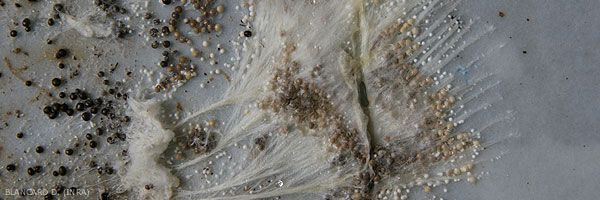
Athelia rolfsii (Curzi) C.C. Tu & Kimbr. (1978)
stem rot Athelia
- synonyme : Sclerotium rolfsii (1911)
- English names: Athelia stem rot, Southern blight
- Distribution and damage
This basidiomycete is particularly prevalent in hot tropical and sub-tropical regions. It affects a very large number of plants, whether or not cultivated, more than a hundred among the mono and dicotyledons. It is rarely very serious on salad .
In France, it is present in the soil of a few market gardeners located in the Basque Country. It is particularly serious in the overseas departments.
- Symptoms
Of moist lesions develop on leaves located in contact with the ground (Figure 1). The rot sets in and progressively reaches the crown, certain roots, the base of the petioles; it spreads to the apple. Affected tissues turn brown more or less intensely. We also observe wilting , yellowing of leaves as well as a collapse of the plants followed by their progressive decomposition. Affected plants are distributed in more or less large foci. A white mycelium (figure 2), sometimes abundant, covers the base of the plants and the soil. It is sometimes surmounted by numerous small smooth sclerotia (figure 3), rather spherical (1 to 3 mm), tawny to reddish brown in color.
- Elements of biology
It is preserved in the soil on plant debris, in the form of aggregated mycelium (figure 4) or sclerotia . It is also able to maintain itself on different organic substrates. It infects a large number of hosts, in particular vegetables: beans, chard, cabbage, solanaceae, cucurbits ... It directly penetrates the tissues that it breaks down and invades thanks to a powerful enzymatic system. The hot and humid periods favor its extension. It grows well between 25 and 35 ° C . Its transmission is ensured by contaminated soil, tillage, water and plants produced in infested nurseries.
- Protection
A number of control methods recommended to combat Thanatephorus cucumeris or Sclerotinia spp. can be used, both in nurseries and in cultivation ( destruction residues of crop and weeds, soil disinfection , " solarization ", crop rotations with corn and other cereals). Note that some fungicides have been tested; the cost of the treatments makes them unusable in a good number of situations.
NB: As legislation on pesticides evolves very quickly, we advise you to consult the e-phy site of the Ministry of Agriculture and Fisheries which is an online catalog of plant protection products and their uses, fertilizers and culture media approved in France . This also applies to all biological products based on microorganisms or natural substances.





